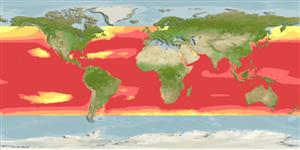分类 / Names
俗名 | 同种异名 | Catalog of Fishes(属, 种) | ITIS | CoL | WoRMS | Cloffa
Environment: milieu / climate zone / depth range / distribution range
生态学
海洋; 半咸淡水; 海洋洄游的 (Ref. 51243); 深度上下限 1 - 1602 m, usually 1 - 250 m (Ref. 6390). 熱帶; 15°C - 31°C (Ref. 168); 50°N - 50°S, 180°W - 180°E
Worldwide in tropical and subtropical seas, but absent from the Mediterranean Sea. Highly migratory species.
遍及全球的熱帶與亞熱帶的海洋, 但是地中海沒有出現。 高度遷移的種,1982年海事法會議的附件一.(參考文獻 26139)
Length at first maturity / 大小 / 重量 / 年龄
Maturity: Lm 103.3, range 78 - 158 cm
Max length : 239 cm FL 雄鱼/尚未辨别雌雄; (Ref. 40637); common length : 150 cm FL 雄鱼/尚未辨别雌雄; (Ref. 168); 最大体重: 200.0 kg (Ref. 26550); 最大年龄: 9 年 (Ref. 72462)
背棘 (总数) : 11 - 14; 背的软条 (总数) : 12 - 16; 臀棘: 0; 臀鳍软条: 11 - 16; 脊椎骨: 39. This large species is distinguished by the following characters: elongate, fusiform body, slightly compressed laterally; total gill rakers on first gill arch 26-34; dorsal fins 2 and separated only by a narrow interspace, the second followed by 8-10 finlets; anal fin followed by 7 to 10 finlets; large specimens may have very long second dorsal and anal fins, becoming well over 20% of fork length; pectoral fins moderately long, usually reaching beyond second dorsal-fin origin but not beyond end of its base, usually 22-31% of FL; 2 flaps (interpelvic process) between pelvic fins; body with very small scales; corselet of larger scales developed but not very distinct; caudal peduncle very slender, bearing on each side a strong lateral keel between 2 smaller keels; no striations on ventral surface of liver; swimbladder present. Colour of back metallic dark blue changing through yellow to silver on belly; belly frequently crossed by about 20 broken, nearly vertical lines; dorsal and anal fins, and dorsal and anal finlets bright yellow, the finlets with a narrow black border (Ref. 9684).
鱼具有非常长的第二背鳍鳍与臀鳍, 在一些里面可能达到远超过 20% 的 FL。 胸鳍是中等长度的, 通常超过第二个背鳍起点但是不超过它的基底的末端。 色彩是黑色的金属深蓝色改变过黄色到银色的在腹面上。 腹面时常有大约 20条断掉的, 几乎垂直的线。 背鳍与臀鳍与离鳍是鲜黄色的。
An oceanic species occurring above and below the thermoclines. Pelagic in open water , but rarely seen near reefs (Ref. 48637). They school primarily by size, either in monospecific or multi-species groups. Larger fish frequently school with porpoises, also associated with floating debris and other objects. Feed on fishes, crustaceans and squids. It is sensitive to low concentrations of oxygen and therefore is not usually caught below 250 m in the tropics (Ref. 28952, 30329). Peak spawning occurs during the summer, in batches (Ref. 9684, 51846). Eggs and larvae are pelagic (Ref. 6769). Encircling nets are employed to catch schools near the surface (Ref. 9340). Caught mainly with longlines and purse seines. Marketed mainly fresh, frozen, canned (Ref. 9684), but also smoked (Ref. 9987). Highly valued for sashimi (Ref. 26938).
出现在温水层上下的一个大洋性的种。 一个开放水域大洋性, 但是很少见到在礁的附近.(参考文献 48637) 他们主要依照大小群集, 形成单一鱼种或多种群。 较大的鱼时常与鼠海豚一起群游, 也伴随着漂浮的残砾与其他的目标。 捕食鱼,甲壳动物与乌贼。 它是对低溶氧量敏感因此不常在热带中被在 250 公尺之下捕捉.(参考文献 28952,30329) 生殖高峰发生于夏天, 成批.(参考文献 9684) 围网被用来捕捉鱼群接近水表面。 (参考文献 9340) 主要地在市场上销售冻结而且装于罐头 (參考文獻 9684), 也生鮮地 (參考文獻 9340) 而且煙燻.(參考文獻 9987) 高度價值用作生魚片.(參考文獻 26938)
Life cycle and mating behavior
成熟度 | 繁殖 | 产卵场 | 卵 | 孕卵数 | 仔鱼
Spawn throughout the tropical and equatorial waters of the major oceans (Ref. 6390). At higher latitudes, spawning is seasonal, with peaks in summer; may continue throughout the year at lower latitudes (Ref. 6390).
Yellowfin tuna are multiple spawners, ie they spawn every few days over the spawning period (Ref. 6390). Eggs and sperm are released into the water for fertilisation (Ref. 6390).遍及全球的熱帶與亞熱帶的海洋, 但是地中海沒有出現。 高度遷移的種,1982年海事法會議的附件一.(參考文獻 26139)
Collette, B.B. and C.E. Nauen, 1983. FAO Species Catalogue. Vol. 2. Scombrids of the world. An annotated and illustrated catalogue of tunas, mackerels, bonitos and related species known to date. Rome: FAO. FAO Fish. Synop. 125(2):137 p. (Ref. 168)
世界自然保护联盟红皮书 (Ref. 130435: Version 2024-1)
人类利用
渔业: 高经济性; 养殖: 实验的; 游钓鱼种: 是的
工具
特别资料
下载 XML
网络资源
Estimates based on models
Preferred temperature (Ref.
123201): 16.5 - 28.9, mean 26.7 °C (based on 6382 cells).
Phylogenetic diversity index (Ref.
82804): PD
50 = 0.5039 [Uniqueness, from 0.5 = low to 2.0 = high].
Bayesian length-weight: a=0.01445 (0.01183 - 0.01766), b=3.03 (2.99 - 3.07), in cm total length, based on LWR estimates for this species (Ref.
93245).
营养阶层 (Ref.
69278): 4.4 ±0.4 se; based on diet studies.
Generation time: 2.8 (2.3 - 3.5) years. Estimated as median ln(3)/K based on 46
growth studies.
回复力 (Ref.
120179): 中等的, 族群倍增时间最少 1.4 - 4.4年 (K=0.13-0.42; tm=2-5; tmax=8; Fec=200,000).
Prior r = 0.36, 95% CL = 0.24 - 0.54, Based on 9 full stock assessments.
Fishing Vulnerability (Ref.
59153): Moderate to high vulnerability (46 of 100).
Climate Vulnerability (Ref.
125649): Moderate vulnerability (42 of 100).
Nutrients (Ref.
124155): Calcium = 41 [22, 86] mg/100g; Iron = 2.84 [1.17, 6.68] mg/100g; Protein = 23.7 [22.2, 25.1] %; Omega3 = 0.274 [0.166, 0.457] g/100g; Selenium = 82.4 [21.0, 256.4] μg/100g; VitaminA = 29.6 [3.7, 227.6] μg/100g; Zinc = 0.524 [0.292, 0.972] mg/100g (wet weight); based on
nutrient studies.
